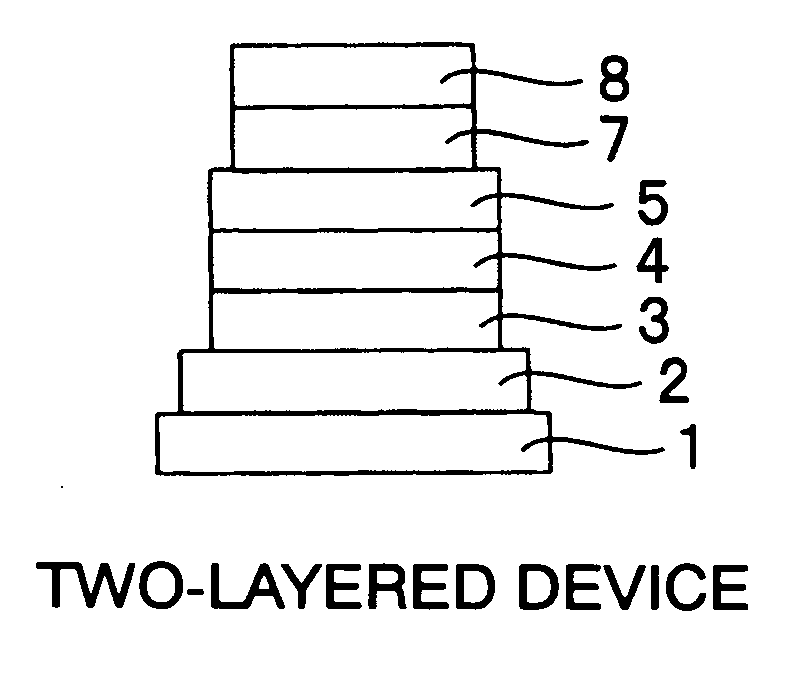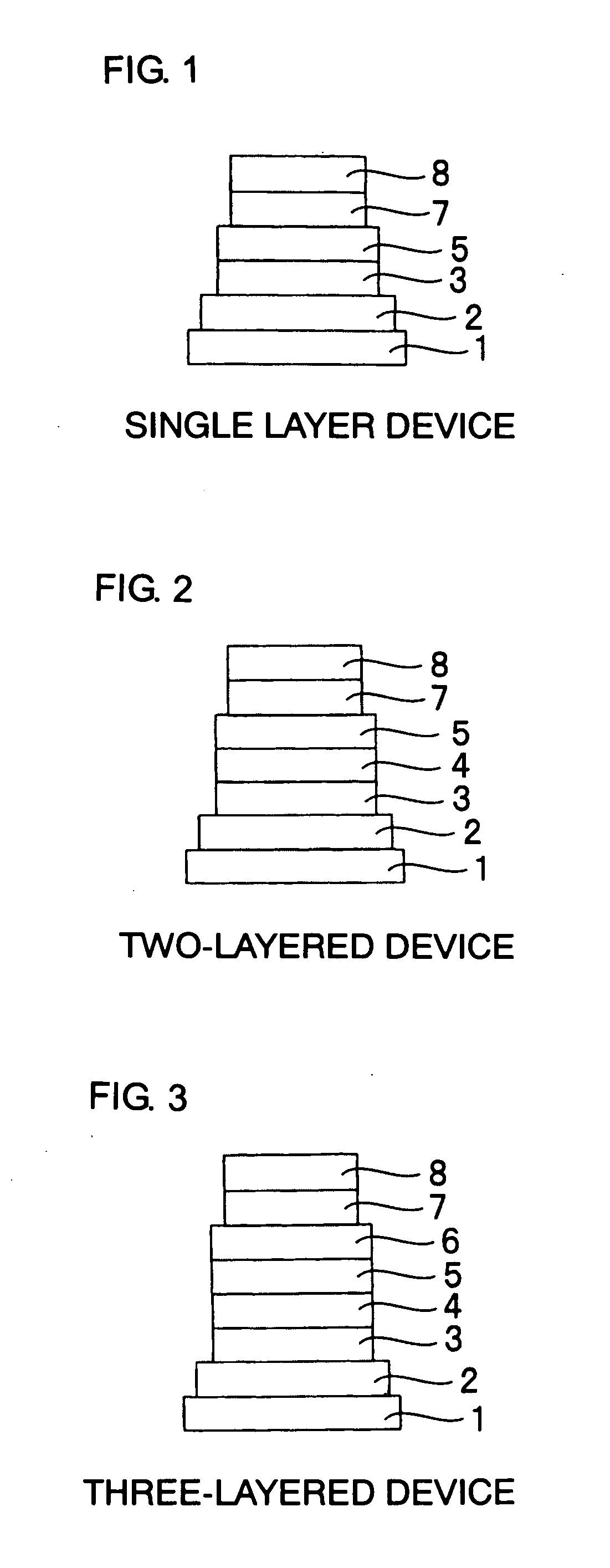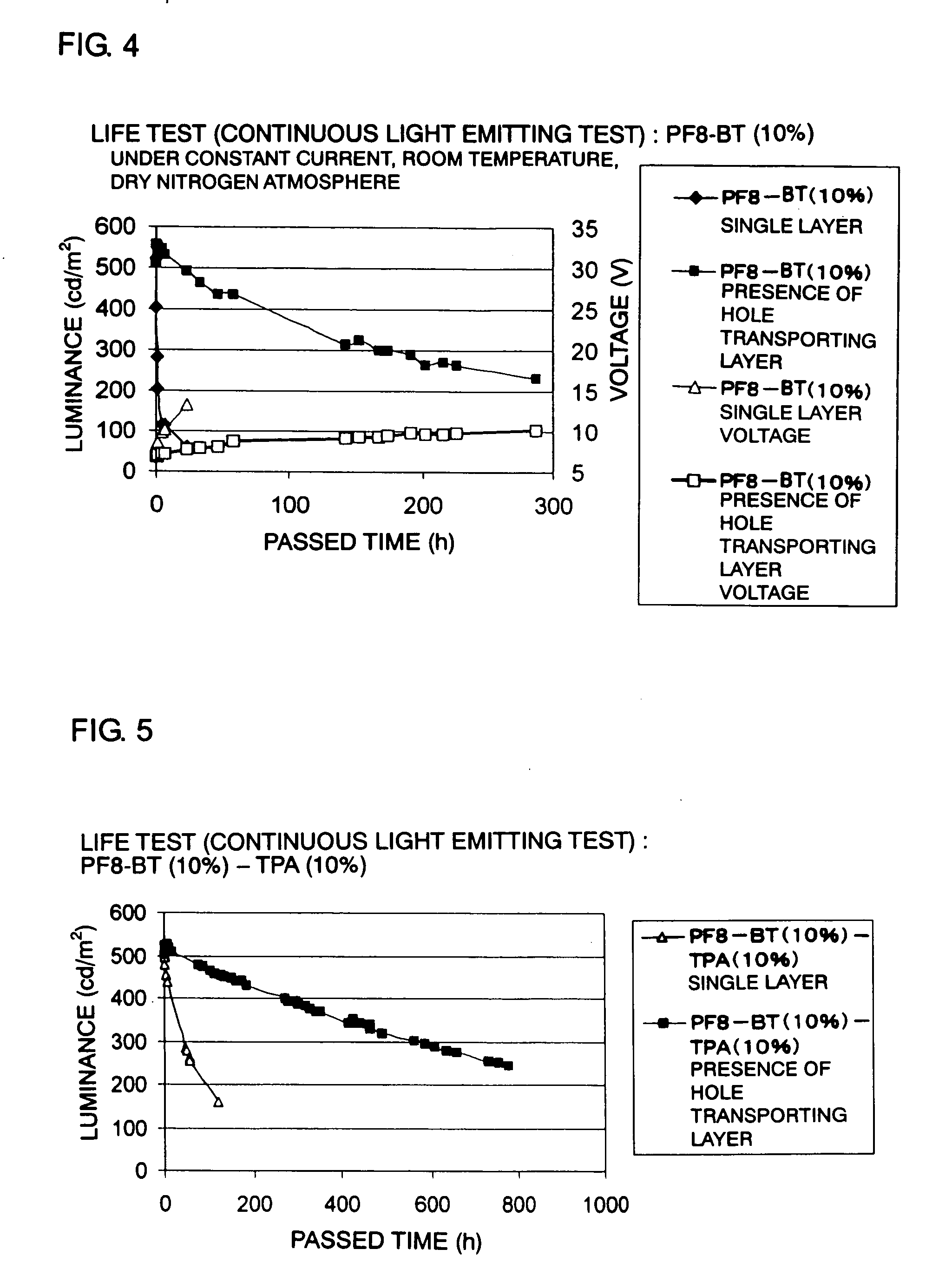Organic electroluminescent device and process for preparing the same
- Summary
- Abstract
- Description
- Claims
- Application Information
AI Technical Summary
Benefits of technology
Problems solved by technology
Method used
Image
Examples
preparation example 1
Preparation of poly[(9,9-dioctylfluorene-2,7-diyl)-alt-(triphenylamine-4,4′-diyl)][polymer 1] (PF8-TPA)
[0045]
[0046] To a reactor equipped with a stirrer, a rubber septa, and an inlet to a vacuum and nitrogen manifold were added 4,4′-dibromotriphenylamine (201.5 mg, 0.5 mmol), 9,9-dioctylfluorene-2,7-bis(4,4,5,5-tetramethyl-1,3,2-dioxoborolane (321 mg, 0.5 mmol), a Suzuki coupling catalyst, 5ml of toluene, and 8ml of an aqueous basic solution. The reactor was evacuated, purged with nitrogen three times, and heated to 90° C. Under the nitrogen atmosphere, the reaction solution was retained at 90° C. for about 3 hours. Then, 61 mg of phenylboric acid was added, and the reactor was further retained at 90° C. for 2 hours under the nitrogen atmosphere. Thereafter, about 0.12 ml of bromobenzene was added, and the reaction solution was retained at 90° C. for 2 hours under the nitrogen atmosphere.
[0047] Then, in order to precipitate a polymer, the reaction mixture was poured into 300 ml of...
preparation example 2
Preparation of poly[(9,9-dioctylfluorene-2,7-diyl)-alt-(9-butylcarbazole-3,6-diyl)][polymer 2] (PF8-Cz)
[0048]
[0049] To a reactor equipped with a stirrer, a rubber septa, and an inlet to a vacuum and nitrogen manifold were added 3,6-dibromo-9-butylcarbazole (190.5 mg, 0.5 mmol), 9,9-dioctylfluorene-2,7-bis(4,4,5,5-tetramethyl-1,3,2-dioxoborolane (321 mg, 0.5 mmol), a Suzuki coupling catalyst, 5 ml of toluene, and 8 ml of an aqueous basic solution. The reactor was evacuated, purged with nitrogen three times, and heated to 90° C. Under the nitrogen atmosphere, the reaction solution was retained at 90° C. for about 3 hours.
[0050] Then, 61 mg of phenylboric acid was added, and the reactor was further retained at 90° C. for 2 hours under the nitrogen atmosphere. Thereafter, about 0.12 ml of bromobenzene was added, and the reaction solution was retained at 90° C. for 2 hours under the nitrogen atmosphere.
[0051] Then, in order to precipitate a polymer, the reaction mixture was poured int...
preparation example 3
Preparation of poly[(9,9-dioctylfluorene-2,7-diyl)-alt-(benzothiadiazole-4,7-diyl)][polymer 3] (PF8-BT)
[0052]
[0053] To a reactor equipped with a stirrer, a rubber septa, and an inlet to a vacuum and nitrogen manifold were added 4,7-dibromobenzothiadiazole (147 mg, 0.5 mmol), 9,9-dioctylfluorene-2,7-bis(4,4,5,5-tetramethyl-1,3,2-dioxoborolane (321 mg, 0.5 mmol), a Suzuki coupling catalyst, 5 ml of toluene, and 8 ml of an aqueous basic solution. The reactor was evacuated, purged with nitrogen three times, and heated to 90° C. Under the nitrogen atmosphere, the reaction solution was retained at 90° C. for about 3 hours. Then, 61 mg of phenylboric acid was added, and the reactor was further retained at 90° C. for 2 hours under the nitrogen atmosphere. Thereafter, about 0.12 ml of bromobenzene was added, and the reaction solution was retained at 90° C. for 2 hours under the nitrogen atmosphere.
[0054] Then, in order to precipitate a polymer, the reaction mixture was poured into 300 ml o...
PUM
| Property | Measurement | Unit |
|---|---|---|
| Molar density | aaaaa | aaaaa |
| Molar density | aaaaa | aaaaa |
| Molar density | aaaaa | aaaaa |
Abstract
Description
Claims
Application Information
 Login to View More
Login to View More - R&D
- Intellectual Property
- Life Sciences
- Materials
- Tech Scout
- Unparalleled Data Quality
- Higher Quality Content
- 60% Fewer Hallucinations
Browse by: Latest US Patents, China's latest patents, Technical Efficacy Thesaurus, Application Domain, Technology Topic, Popular Technical Reports.
© 2025 PatSnap. All rights reserved.Legal|Privacy policy|Modern Slavery Act Transparency Statement|Sitemap|About US| Contact US: help@patsnap.com



